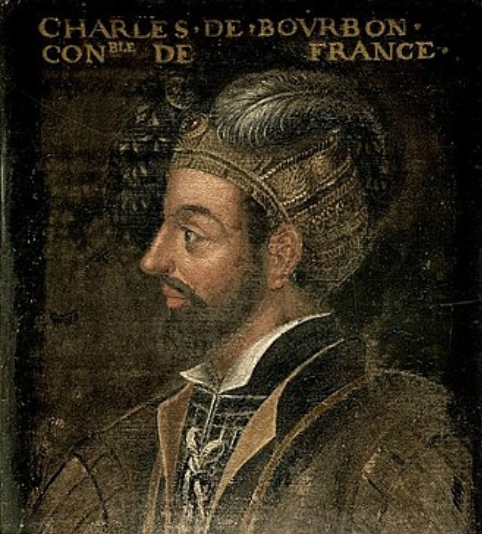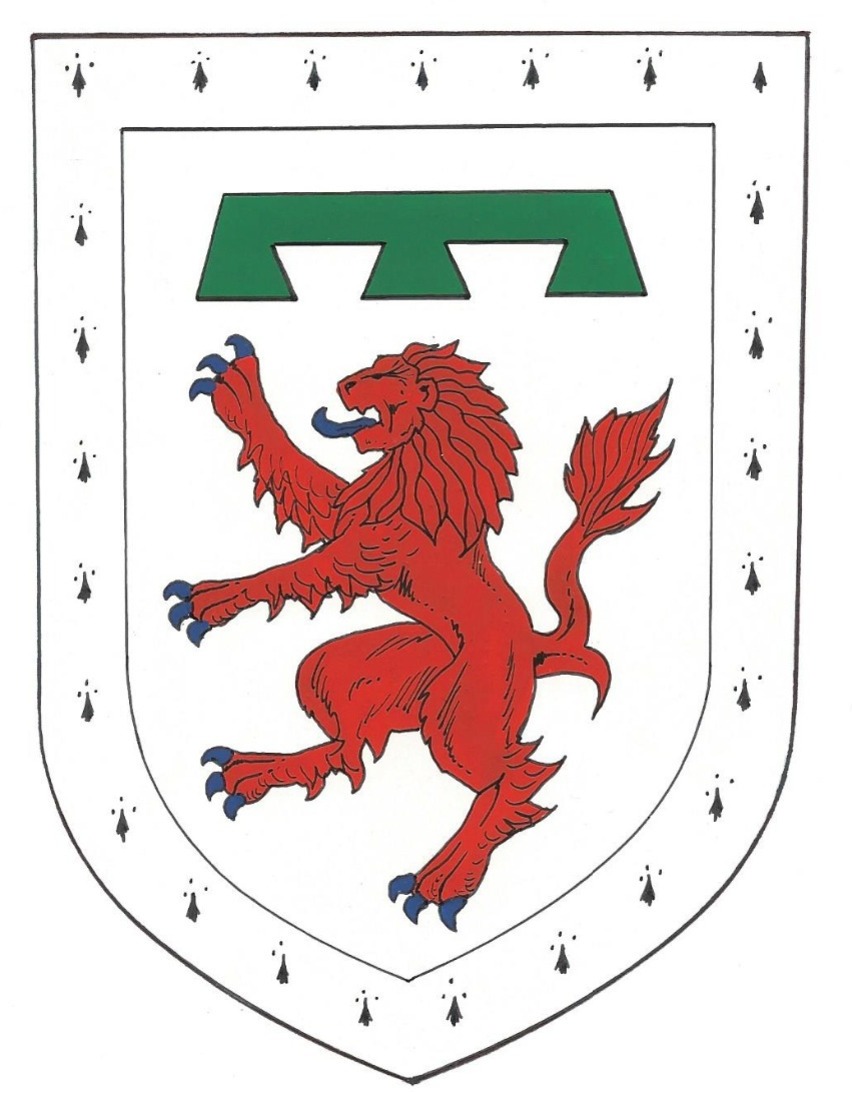Charles de Bourbon-Montpensier
Sovereign Grand Commander 1508-1527


Charles de Montpensier as he was known as was probably the most powerful lord in France during the 16th century and the last of the great feudal lords to oppose the King of France. Born in Montpensier a commune in the Puy-de-Dome department of central France in 1490, he was the second son of Gilbert Count of Montpensier,Clermont and dauphin of Auvergne, head of a junior branch of the House of Bourbon and Clara Gonzaga whom herself was daughter of Federico Gonzaga Marquess of Mantua and Margaret of Bavaria. His sister married Antoine, Duke of Lorraine and Bar, son of Rene II of Anjou and his second wife and as such he was grandson of Iolande de Bar and great grandson of Rene de Anjou.
Charles gained a rapid succession by virtue of the death of his father in 1496 quickly followed by that of his eldest brother in 1501and finally in 1503 his father’s cousin Pierre II, duc de Bourbon died leaving no male heirs. Charles then married Pierre’s daughter Suzanne and so inherited the domains of the ducal line of Bourbon as well as those of Montpensier and in 1505 at the age of 15 not only became one of the richest noblemen but also one of the most powerful men in France.
History tells us he had a brilliant military career accompaning Louis XII to Genoa in 1507 and taking part in the siege of that city where he commanded a force of one hundred men at arms and one hundred archers, two years later he fought against the Venetians at Agnadello. In 1512 he was appointed Governor of the Languedoc and in that same year the king sent him to fight Ferdinand II of Aragon who was at that time threatening Navarre; in 1513 commanding an army of 16,000 men at arms, 4000 cavalry and 3,000 foot soldiers he defended Burgundy against the Swiss army of Maximilian I of Habsburg.
Because of his distinguished service during the Italian Wars he was appointed Constable of France* by King Francis I in 1515 the same year his elder brother died and so he became Duke of Bourbon and Auvergne. He was at the age of twenty five appointed Constable and Viceroy of Milan as his reward for service at the Battle of Marignano where he commanded the vanguard which made the young King Francis I, Master of the Milanese and during this period Charles Bourbon became acquainted with Leonardo da Vinci whom he attached to his army as a military engineer between 1515 and 1517.
Whilst at Milan he successfully defended it against the Imperial troops, of the Holy Roman Emperor Maximilian. King Francis however was becoming uneasy with the Dukes attitude and increasing power and so Francis recalled him from Milan and replaced him with Marshal Lautrec. In addition to this ignomious recall the king also refused to honour Bourbons debts probably accrued due to Charles not being paid a salary since his investiture in Milan. Charles became further angered when the King appointed his own brother in law Charles I of Alençon as commander of the vanguard during the campaign in the Netherlands, a position which Montpensier thought should have been his.
The death of Charles’s wife in 1521 further exacerbated the situation with the royal family; as although his wife had left him all her estates, they were claimed by the King`s mother through her being a granddaughter of Charles Ist Duke of Bourbon. In order to reach a solution without recourse to law the King`s mother proposed marriage to Charles which he promptly refused (Louise being forty-five at the time and Charles Bourbon fourteen years younger). The matter was placed before Parliament and although the king had no real case in law, Parliament delayed in making any decision in the matter and instead ordered the property to be sequestered and in effect make the crown a trustee, the result of which was that the King gained control of Bourbons estates. The heir general who should have had the estates if not Charles Bourbon was in fact the
Emperor Charles V who was a direct heir of the eldest aunt of Bourbon’s wife Suzanne.
By this time Charles Montpensier must have been incensed for he then made a secret agreement with England’s King Henry VIII and offered his services to Charles V the Holy Roman Emperor and as a result, the Holy Roman Emperor and King Henry hatched a plan to partition France with the Emperor taking the Languedoc, Burgundy, Champagne and Picardy, Charles taking Provence and the Dauphine with King Henry VIII having the remainder from Normandy to Guienne. In addition, Charles was to receive the hand of Eleanor queen dowager of Portugal or another of the Emperors sisters.
Unfortunately for all three but particularly for the Duke of Bourbon the plot was discovered before it was carried out and Charles was stripped of all his titles by the king and so in 1523 he fled to Italy where he became Lieutenant General of the Emperor’s army in Italy where he defeated the French at the battle of Sesia.
In 1524 Charles Bourbon had further success when he drove the French under Bonnuvet out of Lombardy, following which he invaded Provence and besieged Marseille although that city was reprieved by the arrival of a larger force. After fighting in the Battle of Parvia in 1525 during which he defeated and captured the French King Francis; the Emperor gave him command of a mixed Spanish and German army with which he curtailed the activities of Pope Clement VII.
King Francis recovered his freedom in 1526 with the Treaty of Madrid (which not only included Francis giving up his claim to Burgundy) but also the agreement that he should marry Eleanor of Austria (a niece of King Henry VIII of England’s wife Katharine of Aragon) an event which did not happen for a variety of reasons until 1530. In addition, Francis promised Charles Bourbon a free return to France and restoration of his possessions; however, after being released Francis reneged on this agreement claiming he had signed it under duress.
This treaty was a double blow to Bourbon as not only did he not get his lands back but also lost his bride to be, as Eleanor and Charles Bourbon had become engaged in 1523 as part of her brother’s plans to unite the Holy Roman Empire and the Bourbons against France. Cheated of his Kingdom and subsequently his bride, the Holy Roman Emperor CharlesV made Bourbon Constable of Milan again as compensation, ten years after he had held it on behalf of the King of France. He also gave the Duke of Bourbon command of a mixed Spanish-German army (the Germans were mainly Protestant) and sent him to chastise Pope Clement VII who had given his support to France in an attempt to alter the balance of power in the region and free the Papacy from being dominated by the Holy Roman Empire (and the Habsburg dynasty). Unfortunately as left without resources for the upkeep of his army or payment of wages (promised by the English King Henry VIII) the poorly fed 34,000 Imperial troops fresh from having defeated the League of Cognac† went on the rampage across central Italy before finally marching on Rome in May 1527 sacking that city in search of loot and the victorious troops now out of control spent months pillaging and destroying churches, palaces and houses.
It was during the initial attack on Rome that Charles was killed by a bullet in the groin, reputedly from the gun of the artist and goldsmith Benvenuto Cellini†† as he attempted to climb a wall. Phillibert de Chalon, Prince of Orange who was head of the vanguard and had taken command after the death of Bourbon had Charles’s body embalmed before being buried in the chapel of Gaeta near Naples. As a consequence of the collapse of Rome’s defence Pope Clement VII (Guilio de Medici) escaped to Castel Sant Angelo only to be imprisoned there.
By his wife Suzanne, Charles had three sons, twins and Francis of Bourbon all of whom died within the first year of birth and so with Charles’s death the main line of the Dukes of Bourbon became extinct. The junior lines, the Dukes of Vendome, were not allowed to inherit because Charles had forfeited his estates by committing treason. However, the county of Montpensier and the Dauphinate of Auvergne were later returned to his sister. According to Vitold de Golish, Charles had an affair with Alaigne a Mongol princess and by her a son, John Phillip born in 1525. This son lived and remained in the court of the Khan of Delhi where he married and had issue.
* The Constable of France was the first Officer of the crown and as Lieutenant General of the King he outranked all nobles and was second in command only to the king.
† The League of Cognac was an alliance of France, Milan, Venice, Florence and the Papacy
†† In his autobiography Benvenuto Cellini describes the death of the Duke of Bourbon in the following manner, having reached the walls of Rome with his friend Alessandro and seeing the approaching army they fired shots at the attackers attempting to climb the wall and “I discovered afterwards one of us shots had killed the Constable of Bourbon.” Whether it was actually Cellini or his friend Alessandro who killed Charles is not really clear.

























